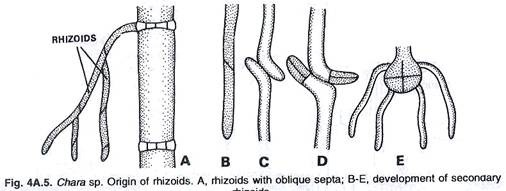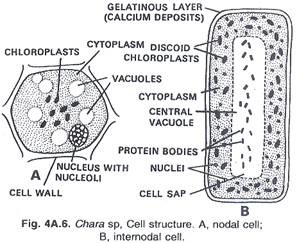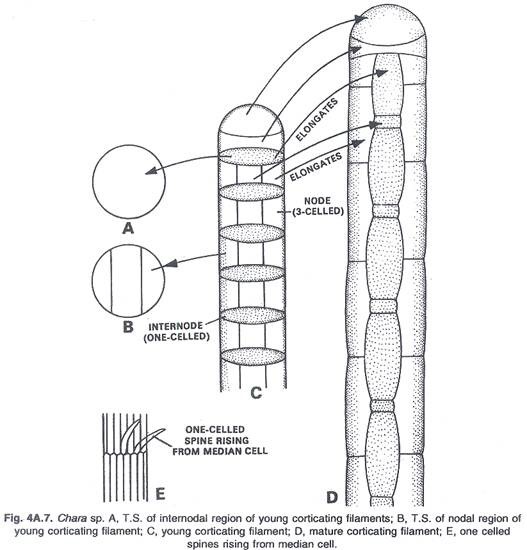ADVERTISEMENTS:
In this article we will discuss about the classification and morphological groups of bacteriophages.
Classification of Bacteriophages:
On the basis of presence of single or double strands of genetic material, the bacteriophages are categorized as under:
1. The ssDNA Bacteriophages:
ADVERTISEMENTS:
(i) Icosahedral phages = φx 174, St-1, φR, BR2, 6SR U3 and G series, e.g., G4, G6, G13, G16. All are like φx 174.
(ii) Helical (filamentous)
(a) The Ft group: They are F specific phages and absorb to the tip of F type sex pilus e g E. coli phages (fd, fl, M13).
(b) If group: They are absorbed to I-type sex pilus specified by R factors, e.g.. If1,IF2, etc.
ADVERTISEMENTS:
(c) The third group is specific to strains carrying RF1 sex factor.
2. The dsDNA Phages:
Following are the examples of dsDNA phages:
(i) T-odd phage of E. coli, e.g., T1, T3, T5, T7.
(ii) T-even phage of E. coli, e.g., T2, T4, T6.
(iii) The other E. coli phages, e.g., P1, P2, Mu, φ80.
(iv) The phages of Bacillus subtilis, e.g., PBS 1, PBSX, SPO1, SPO2.
(v) The phage of Shigella a, e.g., P2.
(vi) The phage of Salmonella; e.g., PI, P22.
ADVERTISEMENTS:
(vii) The phage of Haemophilus, e.g., HP1.
(viii) The phage of Pseudomonas, e.g., PM2.
3. The ssRNA phages.
Examples of the ssRNA bacteriophages are as below:
ADVERTISEMENTS:
(i) Group I:
E. coli. phages such as f2, MS2, M12, R17, fr, etc.
(ii) Group II:
The Qβ phages.
ADVERTISEMENTS:
4. The dsRNA phages.
Example:
The φ6 bacteriophage.
Morphological Groups of Bacteriophages:
On the basis of EM studies, Bradley (1967) has described the following six morphological types of bacteriophages. (Fig. 13.1):
ADVERTISEMENTS:
Type A:
This type of virus has hexagonal head, a rigid tail with contractile sheath and tail fibers dsRNA, T-even (T2, T4, T6) phages.
Type B:
This type of phage contains a hexagonal head but lacks contractile sheath. Its tail is flexible and may or may have tail fiber, for example dsDNA phages, e.g., T1, T5 phages.
Type C:
Type C characterized by a hexagonal head and a tail shorter than head. Tail lacks contractile sheath and may or may not have tail fiber, for example dsDNA phages, e.g., T3, T7.
ADVERTISEMENTS:
Type D:
Type D contains a head which is made up of capsomers but lacks tail, for example ssDNA phages (e.g., φX174).
Type E:
This type consists of a head made up of small capsomers but contains no tail, for example ssRNA phages (e.g., F2, MS2).
Type F:
Type F is a filamentous phage, for example ssDNA phages (e.g., fd, f1).
Further a group G is recently discovered which has a lipid containing envelope and has no detectable capsid, for example a dsRNA phage, MV-L2.
(i) T-Even Phages (dsRNA Virulent Phages):
The T-even phages (T2, T4, T6) are homologous and much of our knowledge about bacteriophages is based on them, particularly T4 phage.
1. Structure:
The T-even phage (Fig. 13.2) is characterized by the presence of a hexagonal head about 900 Å wide. It consists of dsDNA molecule protected by a protein coat made up of numerous facets. The DNA molecule, measuring about 52,000 Å in length, is coiled and packed inside the head. The head is attached with a cylindrical tail consisting of a hollow core surrounded by protein sheath.
The hollow central core measures about 80-100 Å in diameter and is considered continuous from the head to the end of the tail forming a channel through which the nucleic acid moves into invade the host cell being infected. The protein sheath is spirally coiled and is connected to a thin disc-like structure called ‘collar’ at the base of the head and to a hexagonal ‘end plate’ at the end of the tail.
The protein sheath of the tail is capable of contracting in the longitudinal direction. At the six corners of the hexagonal plate there are small ‘spikes’ to which very long fibers called ‘tail-fibres’ are connected. The tail fibres are the organs of attachment to the wall of the bacterial cell.
2. Life-Cycle (Multiplication or Infection Cycle):
The infection cycle (Fig. 13.3) of T-even bacteriophage lasts about 20 minutes, culminating in lysis (bursting-open) of the host cell, E. coli.
The whole process can be classified into:
(i) Adsorption or infection,
(ii) Penetration or injection,
(iii) The eclipse or the latent period
(iv) Maturation and
(v) Lysis or release.
(i) Adsorption or infection:
Attachment of the virus particle onto the surface of the host cell is adsorption or infection. The virus particles possess one or more proteins on the outside that interact with cell surface components called receptors; the receptors are normal surface components of the host (e.g., proteins, carbohydrates, glycoproteins, lipids, lipoproteins, etc.).
Infect, these are the receptors that determine which cells will be susceptible-to infection. In the absence of the receptor site, the virus cannot adsorb and hence cannot infect. If the receptor site is altered, the host may become resistant to virus infection.
(ii) Penetration or Injection:
This process is very interesting and has been studied and beautifully elucidated by B, Kellenberger. After the tail fibres get adsorbed, an ‘enzyme-system’ is supposed to make a pore’ or ‘hole’ in the cell wall of the host.
It is believed that the enzyme-system consists of a ‘phage- lysozyme’, which is synthesized during the multiplication of the parent phage inside the host cell and its molecules remain attached to the extreme tip of the tail-fibres of the new progeny phages.
This enzyme-system becomes active when the released phage particle infects the new host cell. However, the tail-fibres attached on the surface of the host cell bend to bring the end-plate in contact with the cell wall surface.
Now, the protein sheath of the tail longitudinally contracts pushing the central tubular core through the pore inside the wall of the host cell and the phage DNA molecule is released or injected into the cytoplasm. After the DNA is released, the empty protein coat becomes of no use.
(iii) The Eclipse or the Latent Period:
When the DNA molecule is released in the host cytoplasm, it is not degraded by the nuclease enzymes of the host cell. It has been studied, particularly in T4 phage, that the phage DNA contains glucosylated hydroxymethyl cytosine instead of cytosine, which prevents the nucleases of the bacterium from degrading the phage DNA.
The phage DNA. first makes the host cell immune against infection by genetically similar phage particles.
Secondly, it immediately takes over the charge of the cell machinery and suppresses all cellular activities such as synthesis of cellular DNA, RNA, proteins, etc. This is the parasitism of a virus at the genetic level. This suppression is short lived and the cell machinery of protein synthesis starts functioning under the control of viral DNA in the place of cellular-DNA.
New messenger-RNA molecules are synthesized very rapidly and a series of new enzymes, namely, ‘early proteins’ is synthesized. Some of the early proteins are used as enzymes for the viral DNA synthesis.
The newly synthesized viral DNA molecules direct the formation of new type of proteins, namely, ‘late proteins’. Majority of the late proteins are viral coat proteins, whereas some are phage lysozyme. The viral coat proteins constitute the sheath of the phage and the phage-lysozyme later help in the injection process.
(iv) Maturation:
Assembly of the various components to constitute a new phage particle within the host cell is called ‘maturation’. Head and tail formation start separately, the protein components aggregate around the DNA and form the head of the phage.
End-plate is formed first followed by the formation of tubular core. 1 ail fibres are formed later. Hundreds (about 200) of new phage particles are produced from each bacterium by the time of lysis.
(v) Lysis or Release:
After the production of new bacteriophages, the host bacterial cell bursts open and the phage particles are released (Fig. 13.3(J)). Bursting open of the host bacterial cell is called ‘lysis’.
(ii) Lambda (λ) Phage (dsDNA Temperate Phages):
1. Structure:
Morphological structure of phage λ, which infects E. coli K12, is given in Fig 13.4. The phage λ contains double stranded (ds) circular DNA of about 17 µm in length packed in protein head of capsid. The head is icosahedral, 55 nm in diameter consisting of 300-600 capsomers (subunits) of 37,500 dalton. The capsomers are arranged in clusters of 5 and 6 subunits i.e., pentamers and hexamers.
The head is joined to a non-contractile 180 µm long tail by a connector. There is a hole in capsid through which passes this narrow neck portion expanding into a knob like structure inside. The tail possesses a thin tail fibre (25 nm long) at its end which recognises the hosts. Also, the tail consists of about 35 stacked discs or annuli. Unlike T-even phage, it is a simple structure devoid of the tail sheath.
2. Life-Cycle (Multiplication):
The bacteriophage is first adsorbed on the host wall surface and its DNA is injected into the bacterial cell cytoplasm (Fig. 13.5). The viral DNA, instead of starting lytic cycle, gets inserted into the bacterial DNA and travels through many generations by means of the successive divisions of the cell.
Under certain conditions, the inserted viral DNA may get dissociated from the bacterial DNA, and start functioning as virulent phage culminating in the lysis of the host cell. Such conversion of temperate phage (especially pro-phage) into the virulent phage is referred to as ‘induction’, which can be artificially achieved by treatment of the bacterial cells with ultraviolet radiation or with hydrogen peroxide.
(iii) Bacteriophage Mu (Transposable dsDNA Phage):
Mu bacteriophage is temperate, like lambda, but is more interesting due to its unusual property of replicating as a transposible element (transposible elements are sequences of DNA which move from one location to another on their host genome). This bacteriophage is called Mu due to its property of inducing mutations in host genome into which it is integrated.
Its mutagenic property arises because the genome of the phage inserts into the middle of the host genes and these genes become inactive and hence the host behaves as a mutant. Mu is a useful phage as it can be used to generate a wide variety of bacterial mutants very easily. It is also used as vector in genetic engineering.
1. Structure:
Mu phage (Fig. 13.6) is a large dsDNA phage possessing an icosahedral head, a helical tail, and six tail fibres. The DNA molecule of the virion is approximately 39 kilobase pairs long but only 37.2 kilobase pairs make up the actual Mu genome. This is due to the fact that both ends of this DNA molecule contain DNA of the host.
These host DNA sequences are not unique and represent DNA adjacent to the location where Mu was inserted into the DNA of its previous host. Entry of Mu DNA into the head during new progeny formation is so variable that each virion arising from a single infected host cell will have a different amount of host DNA, and the host DNA base sequence in each virion from the same cell will be different.
2. Multiplication:
Genetic map (Fig. 13.7) of Mu genome shows a specific segment called G (distinct from G gene). This segment is invertible and determines the kind of tail fibres that are made for the phage.
Since phage adsorption on host cell is related to the specificity of the tail fibres, the host range of Mu is determined by which orientation of this invertible G segment is present in the virus. If the orientation is G+, then the phage infects E. coli K12. If the orientation is G–, the phage infects E. coli strain C or many other species of enteric bacteria.
When the Mu phage adsorbs on its specific host, its DNA is injected into the cytoplasm and integrates into the host genome. Contrary to lambda (λ) phage, integration of Mu phage DNA into the host genome is essential for both lytic and lysogenic cycle of growth. At the site of host genome where the viral DNA becomes integrated, a five base-pair duplication of the host DNA takes place.
As shown in Fig. 13.8, this host DNA duplication arises because staggered cuts are made in the host DNA at the point where Mu DNA is inserted, and the resulting single-stranded segments are converted into double-stranded segments as part of the integration process.
Mu phage can enter into the lytic cycle either on the beginning of the infection or by induction of a lysogen. The lytic cycle is initiated only if the formation of Mu repressor (the product of gene c) is suppressed. In either case, however, Mu DNA replication involves repeated transposition of Mu to multiple sites on the DNA of the host.
Transcription of only the early genes of Mu takes place in the beginning, but the synthesis of Mu head and tail proteins occurs when gene C protein (a positive activator of late RNA synthesis) is expressed. Eventually, expression of the lytic function occurs and mature progeny-virions are released from the host cell.








